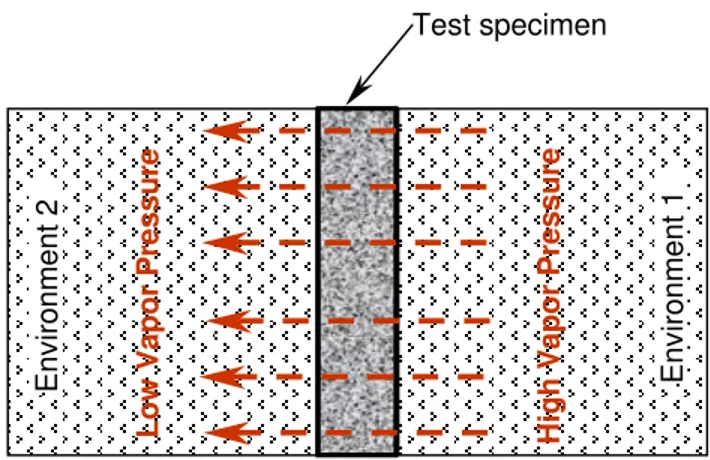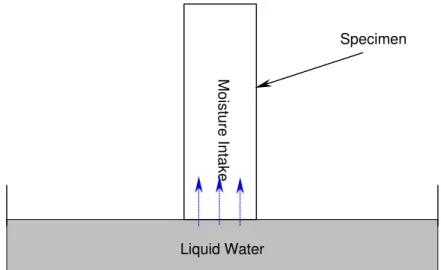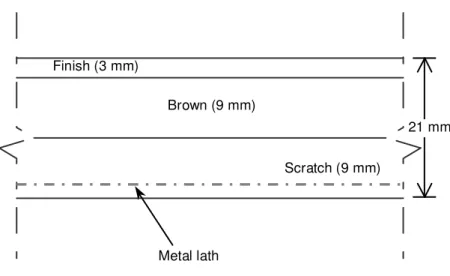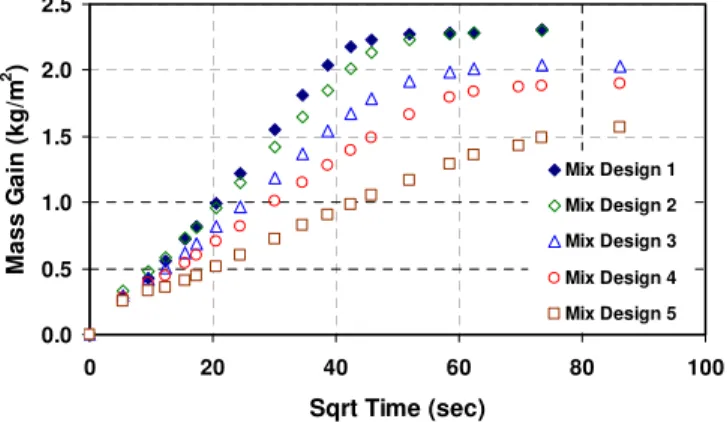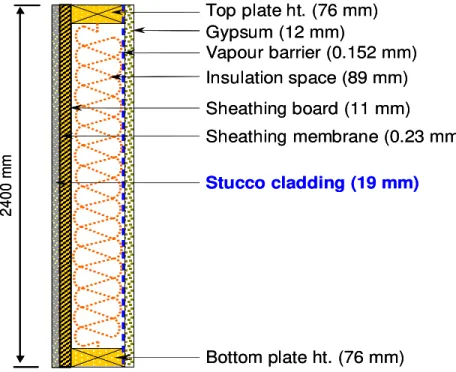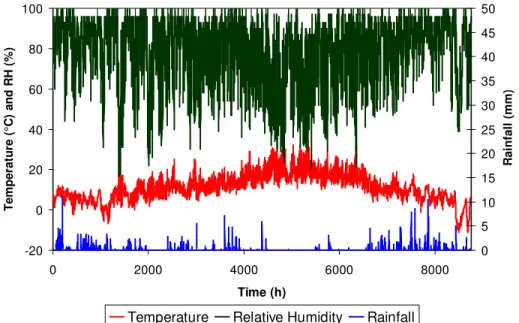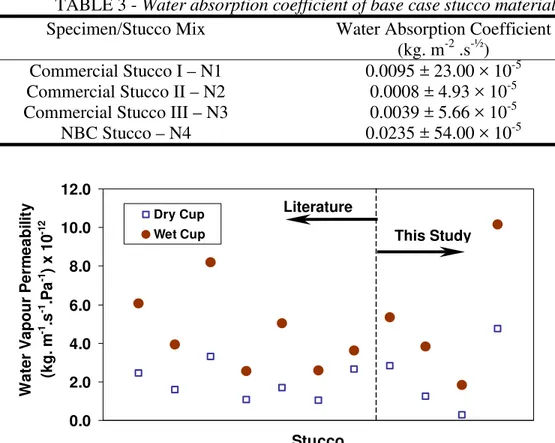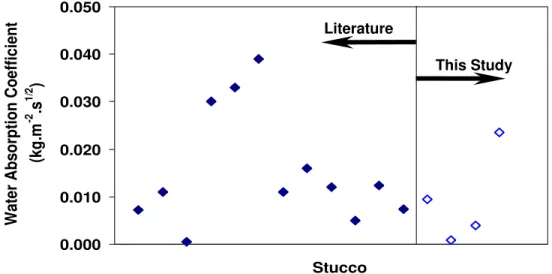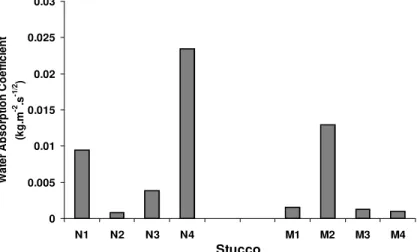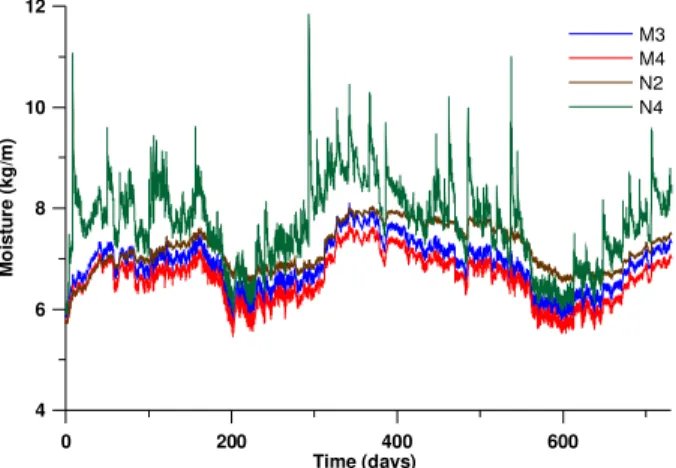Publisher’s version / Version de l'éditeur:
Journal of testing and evaluation, 36, 6, pp. 1-10, 2008-11-01
READ THESE TERMS AND CONDITIONS CAREFULLY BEFORE USING THIS WEBSITE.
https://nrc-publications.canada.ca/eng/copyright
Vous avez des questions? Nous pouvons vous aider. Pour communiquer directement avec un auteur, consultez la
première page de la revue dans laquelle son article a été publié afin de trouver ses coordonnées. Si vous n’arrivez pas à les repérer, communiquez avec nous à PublicationsArchive-ArchivesPublications@nrc-cnrc.gc.ca.
Questions? Contact the NRC Publications Archive team at
PublicationsArchive-ArchivesPublications@nrc-cnrc.gc.ca. If you wish to email the authors directly, please see the first page of the publication for their contact information.
Archives des publications du CNRC
This publication could be one of several versions: author’s original, accepted manuscript or the publisher’s version. / La version de cette publication peut être l’une des suivantes : la version prépublication de l’auteur, la version acceptée du manuscrit ou la version de l’éditeur.
For the publisher’s version, please access the DOI link below./ Pour consulter la version de l’éditeur, utilisez le lien DOI ci-dessous.
https://doi.org/10.1520/JTE101447
Access and use of this website and the material on it are subject to the Terms and Conditions set forth at
High performance stucco to optimum moisture management in wood-frame stucco wall
Mukhopadhyaya, P.; Kumaran, M. K.; Plescia, S.; Lackey, J. C.; Normandin, N.; Van Reenen, D.
https://publications-cnrc.canada.ca/fra/droits
L’accès à ce site Web et l’utilisation de son contenu sont assujettis aux conditions présentées dans le site LISEZ CES CONDITIONS ATTENTIVEMENT AVANT D’UTILISER CE SITE WEB.
NRC Publications Record / Notice d'Archives des publications de CNRC: https://nrc-publications.canada.ca/eng/view/object/?id=be31cff4-5dc9-432d-be0c-4cf5beecb859 https://publications-cnrc.canada.ca/fra/voir/objet/?id=be31cff4-5dc9-432d-be0c-4cf5beecb859
H i g h p e r f o r m a n c e s t u c c o t o o p t i m u m m o i s t u r e m a n a g e m e n t i n w o o d - f r a m e s t u c c o w a l l
N R C C - 5 0 8 6 2
M u k h o p a d h y a y a , P . ; K u m a r a n , M . K . ; P l e s c i a , S . ; L a c k e y , J . ; N o r m a n d i n , N . ; V a n R e e n e n , D .2 0 0 8 - 1 1 - 1 8
A version of this document is published in / Une version de ce document se trouve dans:
Journal of testing and evaluation, v. 36, no. 6, 2008, pp. 1-10
The material in this document is covered by the provisions of the Copyright Act, by Canadian laws, policies, regulations and international agreements. Such provisions serve to identify the information source and, in specific instances, to prohibit reproduction of materials without written permission. For more information visit http://laws.justice.gc.ca/en/showtdm/cs/C-42
Les renseignements dans ce document sont protégés par la Loi sur le droit d'auteur, par les lois, les politiques et les règlements du Canada et des accords internationaux. Ces dispositions permettent d'identifier la source de l'information et, dans certains cas, d'interdire la copie de documents sans permission écrite. Pour obtenir de plus amples renseignements : http://lois.justice.gc.ca/fr/showtdm/cs/C-42
JOURNAL PAPER
Phalguni Mukhopadhyaya1, Kumar Kumaran2, Silvio Plescia3, John Lackey4, Nicole Normandin4 and David van Reenen4
High Performance Stucco to Optimize Moisture
Management in Wood-Frame Stucco Walls
ABSTRACT: Stucco or portland cement plaster is widely used in North America as an exterior cladding material for the wood-frame walls. Recent computer based numerical simulation studies at the National Research Council (NRC) Canada, Institute for Research in Construction (IRC) have indicated that low liquid diffusivity and high water vapor permeability of the stucco material can positively influence the overall moisture management capacity of wood-frame stucco walls. This paper presents the results from experimental and numerical modeling studies carried out at the NRC-IRC on the development of high performance stucco materials and its effect on the overall moisture management capability of wood-frame stucco walls. Liquid water and water vapor transmission properties of several commercial/conventional stucco materials and some newly formulated compositions were measured and compared under laboratory conditions. The experimental results suggest that by appropriate choice of the mix composition, addition of a proper hydrophobic admixture, and using aggregates with a hydrophobic coating, stucco material with lower liquid water diffusivity can be produced without reducing the water vapor permeability. The results from the numerical modeling study show newly developed high performance stucco materials can significantly improve the moisture management capability of wood-frame stucco walls.
KEYWORDS: high performance stucco, water vapor permeability, water absorption, wood-frame stucco walls
Introduction
Wood-frame walls with stucco or portland cement plaster as exterior cladding is extensively used in various parts of North America. These walls, however, experienced moisture related problems in some locations with heavy and sustained rainfall (e.g.
1Research Officer, Institute for Research in Construction, NRC Canada, Ottawa, Ontario, Canada. 2Principal Research Officer, Institute for Research in Construction, NRC Canada, Ottawa, Ontario, Canada.
3Senior Researcher, Technical Research Division, Canada Mortgage and Housing Corporation (CMHC), Ottawa, Ontario, Canada. 4Technical Officer, Institute for Research in Construction, NRC Canada, Ottawa, Ontario, Canada.
Vancouver, British Columbia; Calgary and Edmonton in Alberta; and Wilmington, North Carolina), leading to serious performance problems and financial losses [1].
Moisture management in exterior walls plays an important role in determining long-term durability and serviceability of houses. Improper or inadequate moisture management has caused severe damages, needing expensive home repairs. Local/conventional building materials may not always be the best choice to achieve optimum moisture management in the exterior building envelope, especially in the areas of higher moisture loading. A proper understanding of the mechanisms of moisture transport into and out of the exterior building envelope is required to select the appropriate building materials and its properties that will reduce moisture loading on the exterior building envelope to an optimum level.
The authors have done much work to assess the performance and improve the moisture management in wood-frame stucco walls [2-9]. One of these studies, using numerical modeling tool, show that the combined wetting and drying potential of wood-frame stucco walls is significantly influenced by the water vapor permeability and liquid diffusivity of the stucco material [4,6]. In another investigation it has been demonstrated that of all the major components (stucco, sheathing membrane, sheathing board and vapor barrier) stucco has the most significant variation in the material properties that influence the overall moisture response of stucco walls without rain-screen, exposed to coastal climate in Western Canada [7]. The same study also indicated that a combination of maximum water vapor permeability and minimum liquid diffusivity is desirable for exterior stucco cladding, for optimum moisture management in the wall assembly. These ‘maximum’ and ‘minimum’ values were based on the data available for the existing stucco materials in the NRC-IRC’s material properties database.
Objectives of The Present Work
There are two primary objectives of this research project:
(1) To develop or engineer a high performance portland cement stucco material that will limit liquid water entry through its external surface and at the same time allow water vapor to diffuse out of it, and
(2) To demonstrate, through numerical modeling exercises, that engineered high performance stucco can improve the moisture management capability of wood-frame stucco walls.
Basic Moisture Transport Properties & Measurement
In this study, water vapor permeability and liquid diffusivity are the two basic moisture transport properties that have been determined, using well established test methods. The following paragraphs outline the fundamentals of these two basic moisture transport properties.
Water Vapor Permeability
The water vapor permeability of any building material at unit thickness can be defined as the rate of water vapor transmission per unit area per unit of vapor pressure differential under specified test conditions. The vapor diffusion equation is directly used to determine the water vapor permeability of building materials [10]. The measurements are usually done under isothermal conditions. A test specimen of known area and thickness separates two environments that differ in relative humidity (RH) / vapor pressure (Fig. 1). The rate of vapor flow across the specimen, under steady-state conditions (known constant RH boundary conditions), is then gravimetrically determined. From these data the water vapor permeability of the material is calculated as:
δp = Jv⋅l/(A⋅Δp) (1)
Where,
Jv = Water vapor flow rate across an area A
l = Thickness of the specimen
Δp = Difference in water vapor pressure across the specimen surfaces
Often, especially for membranes and composite materials, one calculates the water vapor permeance, δl , of a product at a given thickness from the above measurements as:
δl = Jv/(A⋅Δp) (2)
ASTM Standard E 96/E 96M - 05, Test Methods for Water Vapor Transmission of Materials, prescribes two specific cases of this procedure- a dry cup method that gives the permeance or permeability at a mean RH of 25 % and a wet cup method that gives the
permeance or permeability at a mean RH of 75 %. For many hygroscopic materials, such as wood and wood products, the water vapor permeability/permeance is a function of the local relative humidity and increases with RH.
Test specimen Low Vapor P ressur e Environme n t 1 Environme n t 2 High Vapor Pressur e
FIG. 1 – Schematic of water vapor transmission across a specimen
Liquid Diffusivity
Liquid diffusivity defines the rate of movement of water within a material, induced by a water concentration gradient. A material that allows liquid water diffusion through its boundary surface would change its weight with time when it is brought in contact with liquid water (Fig. 2). A schematic plot [11] of the increase in weight of the test specimen versus the square root of the time indicates that the specimen weight increases linearly
(Fig. 3) before it comes close to the saturation limit. The slope of this linear variation is
called the water absorption coefficient (Aw) and can be mathematically written as:
⎟ ⎠ ⎞ ⎜ ⎝ ⎛ − = t A M M A t i w (3) where
Mt = weight of the specimen after time 't'
Mi = initial mass of the specimen
A= liquid contact area of the specimen t = time.
In this study, water absorption coefficient is taken as a measurement of liquid diffusivity or rate of movement of water within a material [12] in accordance with the ISO Standard
ISO 15148:2002 (E), Hygrothermal Performance of Building Materials and Products - Determination of Water Absorption Coefficient by Partial Immersion.
FIG. 2 – Schematic of moisture movement into a material from surface contact with liquid water
FIG. 3 - Results from water absorption test
Experimental Work
The experimental work was undertaken in two phases: Phase I – Preparation and testing of base case stucco, and Phase II – Preparation and testing of modified stucco for high performance. Specimen Mois ture Intak e Liquid Water
Weight change / Surface area in
contact with wate
r
Square root of time Aw= Slope
The objective of the Phase I was to establish the basic moisture transport properties, water vapor permeability and water absorption coefficient, of commonly used stucco materials (referred to as the base case stucco in this report) currently available in Canada. Four stucco mixes were used in this phase, including one that was strictly based on the basic minimum requirement of the National Building Code (NBC) of Canada (1995). The objective of Phase II was to develop a modified stucco material that has low water absorption coefficient but high water vapor permeability in comparison with the base case stucco materials tested in the Phase I.
Preparation of Test Specimens
The test specimens were cast in a custom-built pine wood frame (Fig. 4) with internal dimension 380mm×380mm×21mm (thickness). The respective thicknesses of the scratch and brown coats were about 9 mm. The thickness of the finish coat was about 3 mm (Fig. 5). A metallic mesh (metal lath/stucco mesh) conforming to the requirement of the NBC (1995) Canada (Article 9.28.4) was used as the stucco lath embedded inside the scratch coat stucco and nailed with the bottom plate of the wood-frame (Fig. 4). In a typical wood-frame stucco wall assembly a sheathing membrane is normally placed between the stucco and the sheathing board (plywood or oriented strand board). In this study, since the stucco was being studied independently, no sheathing membrane was placed between the metal lath and the bottom plate of the wood-frame.
The stucco mixes were prepared either by following the instructions provided by the manufacturer or as outlined in the NBC (1995) Canada (Article 9.28.5.3). The stucco materials were tested after curing and removal of the wood-frame.
Wooden Box
Metal Lath
FIG. 4 - Custom-built pine wood-frame with metal lath
Scratch (9 mm) Brown (9 mm)
Finish (3 mm)
Metal lath
21 mm
FIG. 5 – Schematic diagram of a three-coat stucco
Phase I - Base Case Stucco
Four stucco mixes, obtained from different sources, used in Phase I were: (1) Commercial Stucco I – N1
(2) Commercial Stucco II – N2 (3) Commercial Stucco III – N3 (4) NBC Stucco – N4
N1, N2 and N3 were selected based on their use in different regions of Canada. These stucco mixes were delivered to the laboratory in bags with instructions on mixing and curing process. These commercial stucco mixes consisted of hydraulic cement, lime, aggregate and additional admixtures to improve workability and physical properties. The mix composition of the finish coat, distinctively different from the scratch coat and brown coat, included color pigment and water resistive ingredients.
The mix design for the NBC Stucco (N4) was done according to the minimum requirement guidelines provided in Part 9, Article 9.28.5, of the National Building Code of Canada, with a composition: Portland Cement (PC): Masonry Cement (MC): Aggregate (graded natural sand) in the ratio 1:1:7. Potable water was added to this mix to achieve required workability. Unlike the commercial stucco N1, N2 and N3, the NBC stucco N4 had a stone dash finish. The stone chips were partially embedded in the brown coat before it started to harden.
Phase II –Modified Stucco for High Performance
The primary objective of this research project lies with the development of modified stucco that will limit liquid water entry on its external surface and at the same time allow water vapor to dry out of it.
Four different cases were studied:
1. Use of a hydrophobic coating on the exterior surface – M1. 2. Use of a hydrophobic aggregate – M2.
3. Use of aggregates coated with hydrophobic chemical – M3. 4. Use of a hydrophobic admixture – M4.
The following paragraphs outline the mix-design and construction details for the aforementioned four modified stucco materials.
Hydrophobic Coatings on Exterior Surface – M1
Hydrophobic materials are those that have low affinity towards liquid water. When liquid water comes in contact with a surface coated with hydrophobic material it tends to form discrete droplets on the surfaces, which coalesce and flow down. These water repellent materials have low surface tension and do not possess active chemical groups on their surfaces to form "hydrogen-bonds" with water. These hydrophobic coatings on the
exterior face of the stucco reduce liquid water entry (i.e. low water absorption coefficient). However, application of hydrophobic coating on the stucco surface may reduce the water vapor transmission capacity [13-14].
The chemical name of the hydrophobic coating used on the exterior surface is Triethoxy-N-Octylsilane. The coating was applied directly on the exterior face of the NBC stucco – N4. The exterior surface of the stucco was cleaned and made free from any residue or loose stone dash finish before applying two flood coats of hydrophobic coating with a paintbrush. An estimated application rate was 0.3 litres/m2 and the coated surface was dried for twenty-four hours before application of the second coat. The stucco specimens were cured for at least seven days before conducting water vapor permeability and water absorption tests.
Use of Hydrophobic Aggregate – M2
Hydrophobic aggregates repulse liquid water coming in contact with it, but allow free air movement through their pores. Presence of such aggregates in the stucco mix will help to reduce the water absorption capacity of the stucco material without reducing its ability to transport air and water vapor across it.
The hydrophobic aggregates used for this purpose had been obtained from a commercial source. The aggregate used in this study is identified as ‘high pH hydrophobic aggregates’ (Fig. 6a), a proprietary product. In order to determine the effectiveness and proportion of hydrophobic aggregate, five mix designs (Table 1), were tested for their water absorption characteristics. The specimens were cast in one coat with a thickness of about13 mm.
TABLE 1 - Various mix designs with hydrophobic aggregate (by volume) Mix Ratio Mix Design No. Portland Cement (PC) Masonry Cement (MC) Aggregate (AG) Hydrophobic Aggregate (HA) Remarks 1 1.0 1.0 7.0 None NBC Stucco – N4 2 1.0 1.0 7.0 0.3 NBC stucco with hydrophobic aggregate 3 1.0 1.0 7.0 0.6 NBC stucco with hydrophobic aggregate 4 1.0 1.0 7.0 1.2 NBC stucco with hydrophobic aggregate 5 1.0 1.0 7.0 1.8 NBC stucco with hydrophobic aggregate
Based on their water absorption characteristics, composition 5 (see Table 1) was considered for further investigation because of its lowest measured water absorption coefficient as shown in Fig. 6b. These specimens had scratch coat, brown coat and stone dash finish, similar to the NBC Stucco – N4 used in Phase-I.
0.0 0.5 1.0 1.5 2.0 2.5 0 20 40 60 80 1 Sqrt Time (sec) M a ss G ai n ( k g /m 2 ) 00 Mix Design 1 Mix Design 2 Mix Design 3 Mix Design 4 Mix Design 5
FIG. 6a - Hydrophobic aggregate FIG. 6b – Water absorption characteristics of various mixes with hydrophobic aggregate
Use of Aggregates Coated with Hydrophobic Chemical – M3
In this case the graded dry natural sand (the same one used for NBC Stucco – N4) was completely soaked in a hydrophobic liquid ‘Octyltriethoxysilane’ and then dried in the ambient conditions (22° C, 50% relative humidity) of the laboratory. The hydrophobic liquid ‘Octyltriethoxysilane’ has the same generic chemical composition as that of the hydrophobic coating (Triethoxy-N-Octylsilane). This treated sand was then used as
hydrophobic aggregate for the stucco mix design. The mix design used for this purpose was PC:MC:AG:HA – 1.0:1.0:7.0:1.8 (same as mix design 5, see Table 1).
Use of a Hydrophobic Admixture – M4
Zinc Stearate (ZS) is a zinc soap that repels water. It has been already demonstrated that the use of Zinc Stearate, as an admixture with lime-pozzolana plaster, can lead to a significant decrease of liquid water transport properties and water vapor sorption capacity of that plaster [15]. However, presence of Zinc Stearate, as an admixture, can significantly decrease or slightly increase the water vapor permeability of the lime-pozzolana plaster, depending on the nature of the pozzolanic admixture used in the lime plaster [15].
In this study, Zinc Stearate (fine, soft white powder, insoluble in water) was used as an admixture to the NBC Stucco – N4 mix design, with a composition of PC:MC:AG:ZS as 1:1:7:0.25.
Numerical Modeling
After evaluating the moisture transport properties of the stucco materials, the influence of the high performance stucco materials on the moisture management or hygrothermal performance of wood-frame stucco walls (Fig. 7) was evaluated using NRC-IRC’s benchmarked numerical simulation tool, hygIRC-2D [16-18].
Based on the results available from the experimental study (see section ‘Experimental Observations – Material Performance’), following four stucco materials were selected for the numerical study:
1. Commercial Stucco II - N2 2. NBC Stucco - N4
3. High Performance Stucco - M3 4. High Performance Stucco - M4 Inputs for Modeling
There are a number of major input parameters required for hygIRC-2D simulation, such as:
2. Material properties 3. Boundary conditions 4. Exposure duration
5. Initial moisture content and temperature
6. Accidental moisture entry, quantity and location
The following sections outline these input parameters as applicable for this study.
Wall Construction Details
Fig. 7 describes the construction details of the wood-frame stucco wall considered in this
study. Gypsum (12 mm) Vapour barrier (0.152 mm) Insulation space (89 mm) Sheathing board (11 mm) Sheathing membrane (0.23 mm) Stucco cladding (19 mm) Bottom plate ht. (76 mm) Top plate ht. (76 mm) 24 00 m m Gypsum (12 mm) Vapour barrier (0.152 mm) Insulation space (89 mm) Sheathing board (11 mm) Sheathing membrane (0.23 mm) Stucco cladding (19 mm) Bottom plate ht. (76 mm) Top plate ht. (76 mm) 24 00 m m
FIG. 7 – Wood-frame stucco clad wall.
Material Properties
Simulations using hygIRC-2D requires eight sets of material properties: air permeability, thermal conductivity, dry density, heat capacity, sorption characteristics, suction pressure, liquid diffusivity, and water vapor permeability.
It is to be noted here that the density, water vapor permeability and liquid diffusivity of all four stucco materials were obtained from respective measured values, as described in the aforementioned paragraphs. The other properties of the selected stucco materials,
however, were taken as the average of all the stucco materials available in the NRC-IRC’s material properties database [19-22]. The material properties for other components of the wood-frame stucco wall (Fig. 7) were also taken from the NRC-IRC’s material properties database.
Boundary Conditions
The two main boundary conditions are the outdoor/exterior condition and the indoor/interior condition.
The exterior boundary condition is defined by specific weather data and has seven components: temperature, relative humidity, wind velocity, wind direction, solar radiation (direct, diffused and reflective components), horizontal rainfall, and cloud index. In this study, simulations were conducted using hourly-recorded weather data at the city of Seattle (WA, USA) with a marine-warm-humid climate. Three typical weather years, representing a Wet, Average and Dry year, were selected. The selection methodology for these years is described in the publication by Cornick et al. [23].
Fig. 8 shows the hourly-recorded data of temperature, relative humidity, and rainfall at
Seattle for the Average weather year.
The interior boundary condition (Fig. 9) has two components: indoor temperature (T) and indoor relative humidity (RH). A summer and winter setting of RH and T were simulated in accordance with ASHRAE recommendations [24] as:
25% RH (constant) and 22°C temperature for winter, and 55% RH (constant) and 25°C temperature for summer.
The summer and winter seasons were identified according to the criteria specified in "Specifications to National (Canada) Energy Code for Houses”, [25], and are defined as follows:
Mean monthly outdoor temperature < 11ºC for winter, and Mean monthly outdoor temperature > 11ºC for summer.
-20 0 20 40 60 80 100 0 2000 4000 6000 8000 Time (h) Te m p er at ur e ( °C ) and R H ( % ) 0 5 10 15 20 25 30 35 40 45 50 R a in fa ll (mm )
Temperature Relative Humidity Rainfall
FIG. 8 - Temperature, relative humidity, and rainfall for the average weather year in Seattle 0 10 20 30 40 50 60 70 80 0 2000 4000 6000 8000 Time (h) Te m pe ra tur e (° C ) a nd R H (% )
Temperature Relative Humidity
Exposure Duration
This study considered a total of three years of exposure duration. The first two years were wet years (same year repeated), while the third year was an average or dry year. The exposure duration for each year started on 1 January and ended on 31 December.
Initial Moisture Content and Temperature
It was assumed in this study that the initial moisture content of each wall component was equivalent to the corresponding relative humidity of 50 percent, derived from the sorption isotherm of the respective materials. The first year of the simulation was considered to be an initial conditioning period, and all the observations were made on the basis of the hygrothermal response of the wall assembly during the second and third years. Similarly, the initial temperature across the entire cross section of the wall was assumed to be 20°C.
Accidental Moisture Entry, Quantity and Location
hygIRC-2D has the capability to inject a certain quantity of moisture that has entered accidentally at any location of the wall and at any time (hourly). The quantity of accidentally entered moisture inside the wall and its location were determined from the output of full-scale and small-scale laboratory tests done in a separate project at the NRC-IRC [26], and from external weather data (rainfall, wind speed and wind direction). In other words, the rate of accidental moisture entry is a function of the rate of wind-driven rain, the air-pressure difference and the type of deficiency in the wall system. In this study, it was assumed that the accidentally entered moisture settled down at the bottom of the insulated stud cavity. For further information regarding the accidental moisture entry feature of hygIRC-2D interested readers may refer to other relevant NRC-IRC publications [2,6].
Experimental Observations – Material Performance
A total of eight types of stucco mixes were considered in this study. Four of them, base case stuccos in Phase I, were tested to establish the water vapor permeability and water absorption characteristics of stucco materials commonly used in Canada. The remaining four stucco mixes, in Phase II, were the stucco materials that were modified with the
intent of developing a high performance stucco material that would have lower water absorption coefficient and higher water vapor permeability in comparison with the base case stucco materials tested in Phase I. The experimental results obtained from the Phase I and Phase II of the study are presented in the following sections.
Base Case stucco
Values of the water vapor permeability and water absorption coefficients of the four base case stucco materials are shown in Tables 2 and 3, respectively. Vapor permeability at 75 percent mean RH (wet cup method) was, in general, higher than the values measured at 25 percent RH (dry cup method). NBC Stucco – N4 showed the highest value and the commercial stucco N3 showed the least water vapor permeability. The measured permeability values compared very well with those in the literature, as shown in Fig. 10
[19-21]. Table 3 shows the values of water absorption coefficient for four base case
stucco materials. NBC Stucco – N4 was the most and Commercial Stucco II – N2 was the least water absorbent material. Fig. 11 shows a comparison of the values of water absorption coefficients obtained in this study and those in the literature [19-21].
The values of measured moisture transport properties (i.e. water vapor permeability and water absorption coefficient) clearly indicate that the base case stucco materials/mixes chosen for this study are very much representative of the contemporary stucco materials used in Canada.
It is also to be noted from Tables 2 and 3 that the base case stucco with very low water absorption coefficient does not have very high water vapor permeability. Thus based on the results obtained in this study, high performance stucco consists of the best attributes of the four base case stuccos that would have a dry cup water vapor permeability of 4.7 × 10-12 kg.m-1.s-1.Pa-1 or higher, a wet cup water vapor permeability of 10.1 × 10-12 kg.m-1.s-1.Pa-1 or higher, and a water absorption coefficient of 0.0008 kg.m-2.s-½ or lower.
TABLE 2 - Water vapor permeability of base case stucco materials Water Vapor Permeability (kg.m-1.s-1.Pa-1) Specimen/Stucco Mix
Dry Cup (25% mean RH) Wet Cup (75% mean RH) Commercial Stucco I – N1 2.80 × 10-12 5.33 × 10-12
Commercial Stucco II – N2 1.22 × 10-12 3.82 × 10-12 Commercial Stucco III – N3 0.28 × 10-12 1.83 × 10-12
NBC Stucco – N4 4.74 × 10-12 10.14 × 10-12
TABLE 3 - Water absorption coefficient of base case stucco materials Specimen/Stucco Mix Water Absorption Coefficient
(kg. m-2 .s-½) Commercial Stucco I – N1 0.0095 ± 23.00 × 10-5 Commercial Stucco II – N2 0.0008 ± 4.93 × 10-5 Commercial Stucco III – N3 0.0039 ± 5.66 × 10-5
NBC Stucco – N4 0.0235 ± 54.00 × 10-5 0.0 2.0 4.0 6.0 8.0 10.0 12.0 Stucco Wate r V ap o u r P er m eab il it y (kg . m -1 .s -1 .P a -1 ) x 10 -1 2 Dry Cup Wet Cup Literature This Study
FIG. 10 – A comparison of water vapor permeability of base case stucco materials with others in the literatures
0.000 0.010 0.020 0.030 0.040 0.050 Stucco Wa ter Ab sorption Co efficien t (k g. m -2 .s 1/ 2 ) Literature This Study
FIG. 11 – Comparison of water absorption coefficient of base case stucco materials with others in literature
High Performance Stucco
As mentioned above, a desirable high performance stucco is the one that has higher than or equal the base case stuccos’ water vapor permeability and lower than or equal base case stuccos’ water absorption coefficient. Four modified stucco mixes were tested for this purpose and the results are shown in Tables 4 and 5.
The experimental results indicate that the stucco mix M2, with a hydrophobic aggregate, has the highest and the stucco mix M4, with Zinc Stearate admixture, has the lowest water absorption coefficient. However, stucco mix M1 (hydrophobic coating on exterior surface) and M3 (aggregates coated with hydrophobic chemical) have relatively low water absorption coefficients close to the value of stucco mix M4. The water absorption coefficients, of stucco mixes M1, M3 and M4 are closer to the lowest values observed in the case of base case stucco (Table 3).
The measured water vapor permeability values of the four modified stucco materials show that stucco mix M1 has the lowest dry and wet cup water vapor permeability (Table 4). These observations indicate that the hydrophobic coating, used in this study, on the exterior surface of the stucco (i.e. stucco mix M1) can reduce the water absorption phenomenon, however, this benefit comes with accompanying reduction in the water vapor permeability.
Stucco mix M4 shows the highest dry cup water vapor permeability (Table 4). It is higher than the highest observed in the base case stucco mixes (N4 in Table 2). However, the wet cup
water vapor permeability of this stucco is almost the same as the dry cup value (i.e. water vapor permeability does not increase with the increase of relative humidity). In fact, the dry cup water vapor permeability of stucco mix M2, M3 and M4 are all higher than the highest value observed in the case of base case stucco. On the other hand stucco mix M3 (aggregates coated with hydrophobic chemical) has the highest wet cup water vapor permeability value and this value is very close to the maximum wet cup value observed in the base case stucco (N4 in Table 2).
TABLE 4 - Water vapor permeability of modified stucco mixes Water Vapor Permeability
(kg.m-1.s-1.Pa-1) Specimen/Stucco Mix Dry Cup (25% mean RH) Wet Cup (75% mean RH) Hydrophobic coating on exterior surface – M1 2.51 × 10-12 3.75 × 10-12
Hydrophobic aggregate – M2 4.85 × 10-12 8.28 × 10-12 Aggregates coated with hydrophobic chemical – M3 6.41 × 10-12 9.09 × 10-12 Zinc Stearate as admixture – M4 7.42 × 10-12 7.47 × 10-12
TABLE 5 - Water absorption coefficient of modified stucco mixes Specimen Water Absorption Coefficient
(kg. m-2 .s-½) Hydrophobic coating on exterior surface – M1 0.0016 ± 6.98 × 10-5
Hydrophobic aggregate – M2 0.0130 ± 38.90 × 10-5 Aggregates coated with hydrophobic chemical – M3 0.0013 ± 7.09 × 10-5
Zinc Stearate as admixture – M4 0.0010 ± 4.81 × 10-5
Comparison – Base Case and Modified Stucco
Results from the experimental observations are summarized in Figs. 12 and 13. Among the base case stucco mixes, N4 had the highest water vapor permeability and the water absorption coefficient values. However, the modified stucco mixes M3 (aggregates coated with hydrophobic chemical) and M4 (zinc stearate as admixture) show promising results with relatively low water absorption coefficient combined with high water vapor permeability. However, these are all trial mixes and there exists the opportunity for further refinement and optimization of these stucco mix designs.
It is well known that water vapor permeability and water absorption coefficient/liquid diffusivity are the two most important moisture transport properties that govern the overall moisture response and management capability of the wall systems with stucco claddings [6,27]. However, it is also to be noted here that there are other hygrothermal
properties (e.g. sorption isotherm, air permeability etc.) that may have some secondary influence on the overall moisture response of the wood-frame stucco wall system. Apart from these, the effect of the desirable hygrothermal properties of the high performance stucco on the moisture response of wall systems with stucco claddings also needs to be investigated. Ideally the moisture management capability of the high performance stucco clad wall systems should be assessed by conducting field tests. However, this would be done in the next phase of this project. At this stage authors have conducted numerical study to highlight the potential positive impacts of the high performance stucco on the wood-frame stucco walls. The results from this numerical modeling study also draw a comparison between selected base case and high performance stucco materials in terms of moisture management capacity of wall systems, as outlined in the following paragraphs. 0 2 4 6 8 10 12 14 16 N1 N2 N3 N4 M1 M2 M3 M4 Stucco W a te r Vapour Pe rm ea bi lit y (x 1 0 -12 k g .m -1 .s -1 .P a
-1 ) Dry Cup Wet Cup
FIG. 12 - Water vapor permeability of base case (N1, N2, N3 & N4) and modified stucco materials (M1, M2, M3 & M4)
FIG. 13 - Water absorption coefficient of base case (N1, N2, N3 & N4) and modified stucco materials (M1, M2, M3 & M4)
0 0.005 0.01 0.015 0.02 0.025 0.03 N1 N2 N3 N4 M1 M2 M3 M4 Stucco W a te r A b s o rp tio n C o e ffi c ie n t (k g .m -2 .s -1 /2 )
Numerical Modeling Observations – Wall Performance
The main reason behind this numerical modeling exercise was to investigate the effect of high performance stuccos on the moisture management capacity of wood-frame stucco walls. For this purpose, based on the experimental results presented in the previous section (Figs. 12 and 13), modified stucco M3 and M4 were selected as high performance stuccos because of their low water absorption coefficient and high water vapor permeance properties. On the other hand stuccos N2 and N4 were selected as representative base case stuccos. Stucco N2 has the lowest water absorption coefficient and moderate water vapor permeability, and stucco N4 has the highest water absorption coefficient and water vapor permeability among the four base case stucco materials considered in this study.
Fig. 14 shows the variation of total moisture content in the wood-frame wall assembly
and Fig. 15 specifically illustrates the moisture content change in the OSB (Oriented
Strand Board) sheathing, during the 2nd and 3rd year of simulation. These plots of moisture content variations show the improved moisture management performance of high performance stuccos (M3 and M4) compared to the NBC stucco (N4) and the commercially available stucco (N2). The maximum and minimum total moisture content of the wood-frame stucco wall show marked changes when high performance stucco material is used as exterior cladding.
Compared to the NBC stucco (N4), there is about 40% reduction of the maximum total moisture content in the wall assembly when high-performance stucco material (M3 or M4) is used as exterior cladding material (Fig. 14). Similar significant reduction in the maximum moisture content is also observed in the OSB sheathing board (Fig. 15). As shown in the case of maximum moisture content, the minimum moisture content of the total wall assembly, as well as in the OSB sheathing board, reduces significantly when high-performance stucco material (M3 or M4) is used as cladding material (Figs. 14 and
15).
Hence, in general it can be concluded from the numerical modeling results that use of high performance stucco material, with low water absorption coefficient and high water
vapor permeability, as external cladding can significantly improve the overall moisture management capability of wood-frame stucco walls.
0 200 400 600 Time (days) 4 6 8 10 12 M o is tu re (k g /m ) M3 M4 N2 N4
FIG. 14 - Total moisture content in the stucco wall (2nd and 3rd year)
0 200 400 600 Time (days) 0 0.5 1 1.5 2 2.5 M o is tu re (k g /m ) M3 M4 N2 N4 N4 – NBC Stucco M4 – Modified Stucco
FIG. 15 - Moisture content in OSB sheathing (2nd and 3rd year)
Conclusions
1. This study shows that it is possible to reduce the liquid water absorption coefficient of the stucco material without reducing water vapor permeability capacity through appropriate mix design.
2. The application of the hydrophobic coating, used in this study, on the exterior face of the stucco reduces the water absorption coefficient and water vapor permeability simultaneously. The effects of other hydrophobic coatings may or may not be similar.
3. Use of aggregates coated with a hydrophobic chemical and the use of zinc stearate as admixture in the stucco mix show promise to develop high performance stucco material with relatively lower liquid water absorption capacity and higher water vapor transmission capacity compared to the stucco materials commonly used in Canada.
4. Further experimental and numerical modeling work on the overall hygrothermal behavior of the stucco materials and the wood-frame stucco wall systems is required to optimize the mix-design of the high performance stucco materials that can maximize the moisture management capability of the wood-frame stucco walls.
5. Investigation on the durability of the stucco properties is required before conclusions can be made with respect to the long-term in situ performance of the stucco mixes developed in this study.
6. Results from numerical modeling indicate that use of high performance stucco materials can significantly improve the moisture management capability of wood-frame stucco walls in a marine-warm and humid climate of Seattle, WA, USA.
Acknowledgement
Funding for this project was provided by The Canada Mortgage and Housing Corporation (CMHC) and the National Research Council (NRC) Canada. Authors are also thankful to SilCoat Ltd. (Israel) for supplying hydrophobic sand and to several other material suppliers for providing raw materials for this research project.
References
[1] Barrett, D., “The Renewal of Trust in Residential Construction - Commission of Inquiry into the Quality of Condominium Construction in British Columbia” Submitted to the Lieutenant-Governor in Council Government of British Columbia, 1998, http://www.hpo.bc.ca/Overview/Barrett1/.
[2] Mukhopadhyaya, P., Kumaran, M.K., Tariku, F., and van Reenen, D., “Application of Hygrothermal Modeling Tool to Assess Moisture Response of Exterior Walls,” Journal of Architectural Engineering, 12, (4), December, pp. 178-186, December 01, 2006, doi:10.1061/(ASCE)1076-0431(2006)12:4(178), (NRCC-47684), URL: http://irc.nrc-cnrc.gc.ca/pubs/fulltext/nrcc47684/.
[3] Mukhopadhyaya, P., Kumaran, M.K., and van Reenen, D., "Vapor Barrier and Moisture Response of Wood-frame Stucco Wall - Results from Hygrothermal Simulation," CIB World Building Congress 2004 (Toronto, Ontario, May 02, 2004), pp. 1-10, May 01, 2004 (NRCC-46864), URL: http://irc.nrc-cnrc.gc.ca/pubs/fulltext/nrcc46864/.
[4] Mukhopadhyaya, P., Kumaran, M.K., Rousseau, M.Z., Tariku, F., van Reenen, D., and Dalgliesh, W.A., "Application of Hygrothermal Analyses to Optimise Exterior Wall Design," 2nd International Conference on Research in Building Physics (Leuven, Belgium, September 14, 2003), pp. 417-426, September 01, 2003 (NRCC-46100) URL: http://irc.nrc-cnrc.gc.ca/pubs/fulltext/nrcc46100/.
[5] Mukhopadhyaya, P., Djebbar, R., Kumaran, M.K., and van Reenen, D., "Moisture Management Strategy in Wood-frame Stucco Wall - Observations from Hygrothermal Simulation," XXX IAHS 31, World Congress on Housing, Housing Process & Product (Montreal, June 23, 2003), pp. 1-8, June 23, 2003 (NRCC-46402), URL: http://irc.nrc-cnrc.gc.ca/pubs/fulltext/nrcc46402/.
[6] Mukhopadhyaya, P., Kumaran, M.K., Tariku, F., and van Reenen, D., “Final Report from Task 7 of MEWS Project at the Institute for Research in Construction: Long-Term Performance: Predict the Moisture Management Performance of Wall Systems as a Function of Climate, Material Properties, etc. Through Mathematical Modeling”, Research Report, Institute for Research in Construction, National Research Council Canada, 132, pp. 384, February 01, 2003, (IRC-RR-132), URL: http://irc.nrc-cnrc.gc.ca/fulltext/rr132/.
[7] Mukhopadhyaya, P., Goudreau, P., Kumaran, M.K., and van Reenen, D., "Influence of Material Properties on the Moisture Response of an Ideal Stucco Wall: Results from Hygrothermal Simulation," 2, 6th Symposium on Building Physics in the Nordic Countries (Trondheim, Norway, June 17, 2002), pp. 611-618, July 01, 2002, (NRCC-45228), URL: http://irc.nrc-cnrc.gc.ca/pubs/fulltext/nrcc45228/.
[8] Mukhopadhyaya, P., Kumaran, M.K., van Reenen, D., and Tariku, F., "Influence of Sheathing Membrane and Vapor Barrier on Hygrothermal Response of Stucco Walls," 1, International Conference on Building Envelope Systems and Technologies (ICBEST) 2001 (Ottawa, Ontario, June 26, 2001), pp. 269-274, July 01, 2001, (NRCC-44986)
[9] Mukhopadhyaya, P., and Kumaran, M. K., "Prediction of Moisture Response of Wood-Frame Walls Using IRC's Advanced Hygrothermal Model (hygIRC)", Proceedings of the 2nd Annual Conference on Durability and Disaster Mitigation in Wood Frame Housing (Madison, WI, U.S.A. November 06, 2000), pp. 221-226, November 01, 2001, (NRCC-44518), URL: http://irc.nrc-cnrc.gc.ca/pubs/fulltext/nrcc44518/.
[10] Joy F. A. and Wilson, A. G., “Standardization of the Dish Method for Measuring Water Vapor Transmission,” Proceedings of the International Symposium on Humidity and Moisture, Washington, D. C., Vol. 4, Chapter 31, 1963, pp 259-270. [11] Kumaran, M. K. “Moisture Diffusivity of Building Materials from Water Absorption
Measurements,” Journal of Thermal Envelope and Building Science, Technomic Publishing Co., Vol. 22, April, 1999, pp. 349-355.
[12] Mukhopadhyaya, P., Goudreau, P., Kumaran, M. K. and Normandin, N., “Effect of Surface Temperature on Water Absorption Coefficient of Building Materials,” Journal of Thermal Envelope and Building Science, 26, (2), 2002, pp. 179-195. [13] Carmeliet, J., Houvenaghel, G., Van Schijndel, J., and Roels, S., “Moisture
Phenomena in Hydrophobic Porous Building Material. Part 1: Measurements and Physical Interpretations”, International Journal for Restoration of Buildings and Monuments, Vol. 8, No. 2/3, 2002, pp. 165-183.
[14] Carmeliet, J., van Besien, T., and Roels, S., “Moisture Phenomena in Hydrophobic Porous Building Material. Part 2: Measurements and Modeling”, International Journal for Restoration of Buildings and Monuments, Vol. 8, No. 2/3, 2002, pp. 185-203.
[15] Černý, R., Kunca1, A., Tydlitát, V., Tesárek, P., Drchalová, J., and Rovnaníková, P., “Hygric, Thermal and Mechanical Properties of Lime Plasters with Pozzolanic Admixtures”, Proceedings of CIB W40 Task Group Meeting on Heat and Moisture Transfer in Buildings, Glasgow, UK, 2004.
[16] Djebbar, R., Kumaran, M.K., van Reenen, D. and Tariku, F., “Hygrothermal Modeling of Building Envelope Retrofit Measures in Multi-unit Residential and Commercial Office Buildings”. IRC/NRC, National Research Council, Ottawa, Canada, Client Final Report B-1110.3, 2002, pp. 187.
[17] Djebbar, R., Kumaran, M.K., Van Reenen, D. and Tariku, F., “Use of Hygrothermal Numerical Modeling to Identify Optimal Retrofit Options for High-rise Buildings”, 12th International Heat Transfer Conference, Grenoble, France, Aug, 2002, (NRCC-45215), 2002, pp. 1-6.
[18] Maref, W., Kumaran, M. K., Lacasse, M. A. Swinton, M. C. and van Reenen, D., “Advanced Hygrothermal Model - hygIRC: Laboratory Measurements and Bench Marking”, 12th International Heat Transfer Conference, Grenoble, 2002, pp. 1-6. [19] Kumaran, K., “A Thermal and Moisture Transport Property Database for Common
Building and Insulating Materials, Final Report from ASHRAE Research Project 1018-RP, 2002, pp. 1-229.
[20] Kumaran, K., Lackey, J., Normandin, N., van Reenen, D. and Tariku, F., “Summary report from Task 3 of MEWS project”, Institute for Research in Construction, National Research Council, Ottawa, Canada, (NRCC-45369), 2002, pp. 1-68. [21] Kumaran, M.K., Lackey, J., and Normandin, N., “Hygrothermal Properties of Eight
Stucco Samples from the Field: Information from a Joint Research Project with CMHC”. Client Report B1013, Institute for Research in Construction, National Research Council Canada, 2000, pp. 10.
[22] Mukhopadhyaya, P., Lackey J., Normandin N., Tariku F., and van Reenen, D., “Hygrothermal Performance of Building Envelope Retrofit Options: Task 1 - A Thermal and Moisture Transport Property Database”, IRC/NRC, National Research Council, Canada, Ottawa, Client Final Report, 2004, pp. 1-37, (B-1137.5).
[23] Cornick, S. M., Dalgliesh, W. A., Said, N. M., Djebbar, R., Tariku, F. and Kumaran, M. K., “Task 4- Environmental Conditions’. Institute for Research in Construction, National Research Council, Ottawa, Canada, (NRCC-45222), 2002, pp. 1-106. [24] ASHRAE Applications Handbook, Chapter 3 - Commercial and Public Buildings,
American Heating, Refrigerating and Air-Conditioning Engineers Inc., Atlanta, 1999.
[25] Swinton, M.C. and Sander, D.M., “Trade-off Compliance for Houses: Specifications for Calculation Procedures for Demonstrating Compliance to the National Energy Code for Houses”, Institute for Research in Construction, National Research Council, Canada, (NRCC-39861), 1994, pp. 46.
[26] Lacasse, M.A., O'Connor, T., Nunes, S.C., and Beaulieu, P., “Report from Task 6 of MEWS Project: Experimental Assessment of Water Penetration and Entry into Wood-Frame Wall Specimens - Final Report”, Research Report, Institute for Research in Construction, National Research Council Canada, 133, pp. 1 v. (various pagings), February 01, 2003, (IRC-RR-133), URL: http://irc.nrc-cnrc.gc.ca/fulltext/rr133/.
[27] Künzel, H. M., Künzel, H. and Holm, A., “Rain Protection of Stucco Facades”, Performance of Exterior Envelopes of Whole Buildings IX International Conference, Clearwater, Florida, USA, 2004, pp. 1-7.
